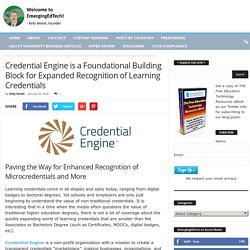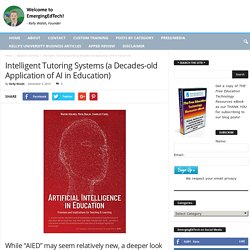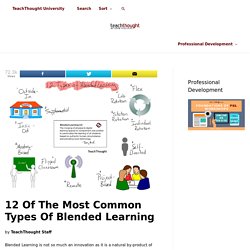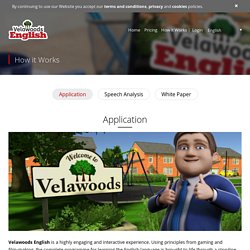

Credential Engine is a Foundational Building Block for Expanded Recognition of Learning Credentials. Learning credentials come in all shapes and sizes today, ranging from digital badges to doctoral degrees.

Yet schools and employers are only just beginning to understand the value of non-traditional credentials. It is interesting that in a time when the media often questions the value of traditional higher education degrees, there is not a lot of coverage about the quickly expanding world of learning credentials that are smaller than the Associates or Bachelors Degree (such as Certificates, MOOCs, digital badges, etc). Deeper Learning for All: Five things to do more of. A couple of weeks into term and, so far, I’ve had the privilege of observing 40 or more lessons.

I’ve seen lots of excellent lessons – it’s such a joy to be around when a teacher is doing great things; where you think how lucky these students are to be here in this room with this teacher. I’ve got a growing mental database of observations from the last year or so and, from that reasonably large sample, I’d suggest there are a few things that teachers could make much more use of. Actually, I’d say that there are some things that are not done nearly enough. Here’s a sample of five: Check for Understanding Straight out of the Rosenshine playbook, this is not nearly a default habit, in my experience. Cutting corners here is what leads to students developing all kinds of masking strategies – pretending they know things they don’t.
Explain + Check instead of teasing out. Rehearse and Repeat: Practise explaining You don’t get good at anything without practice. Short writing practice loops. Dashboard » Quality Content. Intelligent Tutoring Systems (a Decades-old Application of AI in Education) In the last few years, numerous developments have led to a growing awareness of the maturity of Artificial Intelligence.

Self-driving cars and personal assistants like Alexa and Siri are some of the consumer-facing technologies that have helped to fuel this awareness. This knowledge can also bring with it a certain dystopian fear about robots and technology “taking over”. While we should always strive to be cautious with new technologies, our concerns should also be tempered by understanding the long curve of development that typically precedes these seemingly overnight maturings of technology. I've been reading Artificial Intelligence in Education, a 2019 publication by Wayne Holmes, Maya Bialik, and Charles Fadel, that explores implications of AI in the realm of teaching and learning. It has been an enlightening read (and I should add, a very affordable one – so many academic publications are exorbitantly priced, but this one was only $14.95 in paperback form on Amazon).
Blended Learning CookBook - Introduction. 12 Different Types of Blended Learning. By TeachThought Staff Blended Learning is not so much an innovation as it is a natural by-product of the digital domain creeping into physical spaces.

Broadly speaking, blended learning just means a mix of learning online and face-to-face, which means it’s likely your students are already doing some form of blended learning and have for years. As digital and social media become more and more prevalent in the life of learners, it was only a matter of time before learning became ‘blended’ by necessity. Finding The Model That Works For Your School, Classroom, And Students. Build-Your-Own Textbooks Could Save Students Hundreds. GCSE - Kognity. Blended Learning Explained for Teachers. Best way to learn English. White Paper The ingredients of learning: interaction, immersion and instruction.

A white paper which illustrates in detail the key pedagogical learning principles of Velawoods English can be downloaded here. A brief summary of this document follows. Syllabus The syllabus of Velawoods English is built on objectives linked to the Common European Framework of Reference for Languages . Second language acquisition theory Velawoods English ensures that you: understand most of the language in the learning environment, but is challenged by an appropriate amount of new language,are well supported in using your own knowledge and skills to understand the meaning of new vocabulary and structures,feel comfortable and relaxed so that there are no barriers to the effective acquisition of new language.
A communicative approach Velawoods English enables you to experience and actively notice new language in its natural everyday setting. Interaction, immersion and instruction. 20 Math and ELA Tools that Support English Language Learners. As part of our #SupportELL series, we have summarized some products, services and tools that support English Language Learners (ELLs) and their teachers.

To gather information from education technology companies, Getting Smart invited education technology companies to fill out a form to provide information on their ELL adaptations. This is not an endorsement of any particular product, tool or service. When making decisions about specific tools for teachers and students, we strongly encourage research and application demonstrations for applicability in your context, as well as alignment to current new state standards.
If you would like to join the conversation and share other tools, please use #SupportELL on social media to contribute specific technology-enabled tools. Creative Learning Solutions - Edmentum International. Academic Language Learning. How to Implement the 6 Blended Learning Models. - online learning platform for language schools. BLIG 3.0 FINAL.